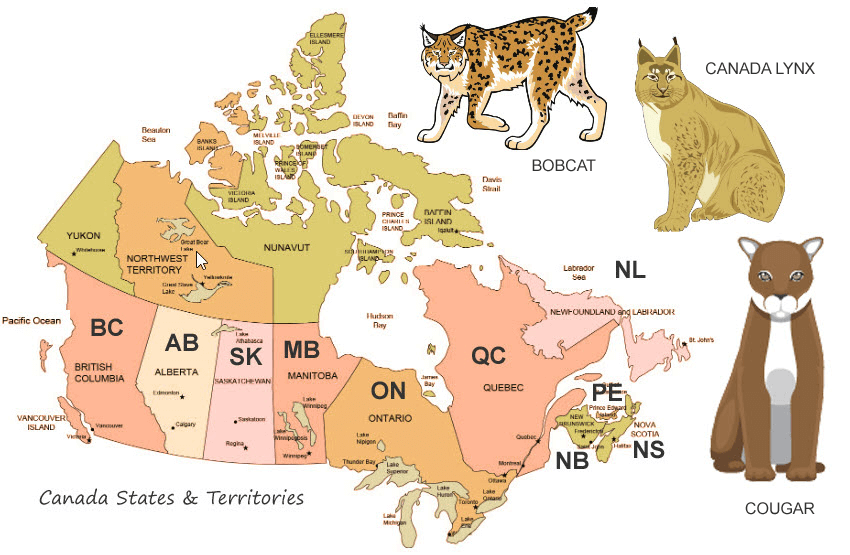There are three wild cats that inhabit Canada, the cougar, bobcat and Canada lynx. Their conservation status of each cat varies depending on the region.
More About Canada
Canada is located in North America. Its borders include the North Pacific Ocean (west), north Atlantic Ocean (east), Arctic Ocean (north), Alaska (northwest) and the United States (south). It is larger than the United States and China, but a little smaller than Russia.
There are 10 provinces (states) in Canada: Alberta, British Columbia, Manitoba, New Brunswick, Newfoundland and Labrador, Nova Scotia, Ontario, Prince Edward Island, Quebec and Saskatchewan. There are also 3 territories: Northwest Territories, Nunavut and Yukon.
Even though Canada is one of the largest countries in the world, very few people live there.
The country’s geography is quite varied (mountains, lowlands, hilly terrain, prairies, lakes, rivers) and its climate is extremely diverse.
 Wild Cats in Canada
Wild Cats in Canada
Canada Lynx (Lynx canadensis) – Inhabit forests with throughout Canada. Trapping is allowed in all states to varying degrees except Nova Scotia. Canada lynx in Nova Scotia are only found on Cape Breton Island and trapping is no longer allowed. its conservation status is Least Concern. The cat’s fur is a sliver/brown. It has tufted ears (short clusters of long strands of hair)) and ruffed (fur that extends outward) face. The Canada lynx primarily feeds on snowshoe hares.
Bobcat (Lynx rufus) – A medium-sized wild cat mostly found in southern Canada. Nova Scotia has the largest bobcat population. The population in Quebec has been decreasing. Hunting and trapping are allowed in every state, but was stopped in Quebec due to declining numbers. Compared to a Canada lynx, the bobcat has smaller feet, shorter tufts of ear hair (or no tufts at all), a bobbed tail and white underbelly. The coat is more of a singular color, sometimes with spots. They live with the lynx in spruce and pine forests from northern and southwestern Ontario to New Brunswick and Nova Scotia. Bobcats prey on rabbits, other types of small mammals and birds.
Cougar (Puma concolor) – The cougar is a big cat that can be found throughout the region. Some people refer to cougars as the largest of the small wild cats. A cougar’s head is round and its ears are stand up straight. It’s fur is a tawny brown color. They don’t communicate as much as other big cats, but can sometimes be heard purring, growling, hissing, chirping and whistling. The cat isn’t seen very often in eastern Canada, but there is evidence it may be returning to the area. Cougars are considered endangered in Saskatchewan, Manitoba, Ontario, Quebec and New Brunswick.
Canada Wild Cat Conservation Organizations
Wild cat conservation groups based in Canada and other organizations working on the preservation of Canadian wild cats.

